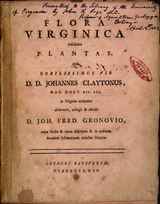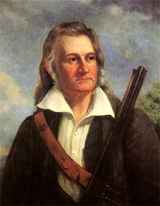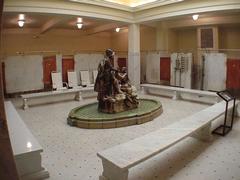Classical Nature 1730-1830
 frog by Catesby
frog by Catesby
|
- 1688 John Banister sent his "Catalogue of Plants observed by me in Virginia" to be published in London in John Ray's Historia Plantarum; Banister's essay was the first printed account of American flora
- 1728 John Bartram began the first botanical garden at Kingsessing on the Schuylkill south of Philadelphia, became America's first botanist, traveled and collected specimens, published his Journal 1751, sent plants to England, appointed Botanist to the King in 1765; son William was a founding member with Ben Franklin of the American Philosophical Society in 1743 in Philadelphia
- 1732 Mark Catesby published The Natural History of Carolina, Florida, and the Bahama Islands in London, based on his travels and sketches made in Virginia from 1712 to 1719, inspired by the earlier works of John Ray
- 1736 James Logan in Pennsylvania was a friend of Bartram and Linnaeus and an experimental naturalist; the Royal Society in London published his Experiments Concerning the Impregnation of the Seeds of Plants and Logan collected one of the largest libraries in America of 3000 volumes
 Clayton's book
Clayton's book
|
- 1739 John Clayton, who had accompanied Mark Catesby on his journeys, sent his collection of plants to J. F. Gronovius who published Flora Virginica, the first systematic compendium of American botany
- 1749 Cadwallader Colden in New York mastered the Linnaean system and published the first volume of his Acta that classified many American plants. His daughter Jane was the first woman botanist in America
- 1755 John Mitchell published his map of America, was a physician and botanist in Virginia, suffered the loss of his botanical collection to French privateers on a trip to England in 1746, was elected to the Royal Society in 1747, became a cartographer for the Board of Trade
- 1752 Dr. Alexander Garden began to classify plants around his Charleston home according to the system of Carolus Linnaeus who named the gardenia after Dr. Garden
- 1789 Andre Michaux, the French naturalist who traveled and collected plants in America, published in Paris his Journal of Andre Michaux, 1787-1796
 Audobon
Audobon
|
- 1798 John Chapman, known later as "Johnny Appleseed" began to plant apple seeds in Pennsylvania, then in Ohio and Indiana, developing nurseries of young trees that he sold to settlers moving west, until his death in 1845. The idea of tree nurseries has been revived today to plant new forests as "heat sinks" for global warming.
- 1808 The Scotsman Alexander Wilson, poet and naturalist and self-taught artist, began publication of American Ornithology, nine volumes of pictures of American birds drawn from models of stuffed birds, and would influence John J. Audobon
- 1818 Massachusetts prohibited the hunting of robins and horned larks
- 1826 John J. Audobon traveled to England to arrange for the printing of The Birds of America, with 435 hand-colored plates of 1,065 individual birds engraved from the original paintings made during Audobon's journeys throughout America during the previous 15 years, drawing freshly-killed birds to give them a natural and lively appearance.
 Hot Springs men's bath
Hot Springs men's bath
|
His London publication was issued in four volumes between 1827 and 1838. The life-size depictions appeared on folio sheets two by three feet, accompanied by a synopsis and index and a companion five-volume Ornithological Biography.
- 1832 Arkansas Hot Springs designated as a national reservation. It is "the smallest and oldest of the parks in the National Park System, dating back to 1832, when Congress established the first federally protected reservation in the nation's history, 32 years ahead of Yellowstone. Hot Springs Reservation, which was renamed Hot Springs National Park in 1921, originally was created by Congress to protect the 47 naturally flowing thermal springs on the southwestern slope of Hot Springs." (from Hot Springs)
Sources: